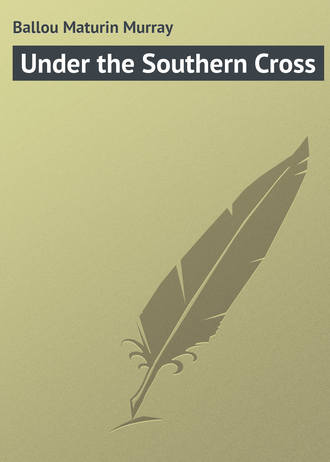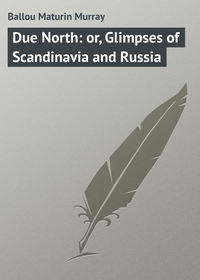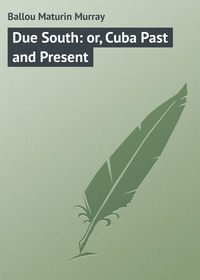 полная версия
полная версияUnder the Southern Cross
On the way to the valley, and indeed all about the environs of the city, one passes large patches, measuring an acre more or less, of submerged land, where is grown the Hawaiian staff of life, – the taro, a root which is cultivated in mud, and mostly under water, recalling the rice-fields as we have seen them in Japan and China. The article thus produced, when baked and pounded to a paste, forms a nutritious sort of dough, like uncooked flour, which is called poi, constituting the principal article of food with the natives, as potatoes do with the Irish or macaroni with the Italians. The baked taro is powdered and mixed with water, after which it is left to ferment; and when this process has taken place it is ready for eating. It is then placed in a large bowl about which the natives squat on their hams, and thrusting their fingers into the blue liquid mass they adroitly convey a mouthful at a time to their lips and rapidly swallow it. It is served in various degrees of thickness; if very thin, it is called two-finger poi, because in order to convey sufficient for a mouthful to the lips two fingers must be used; but if thick, it is one-finger poi. As the lazzaroni of Naples pride themselves upon their expertness in conveying the cooked macaroni to their mouths and down their throats, so the Kanakas become experts in the transmission of poi to satisfy their hunger. These Sandwich Island natives eat a small species of fish resembling our smelts, quite raw, with their poi.
The environs of the city in any direction are composed of well-irrigated gardens, plantations of bananas, clusters of cocoanuts, figs, mangoes, melons, and various tropical fruits. The cocoanut-grove of Waikiki, about four miles from Honolulu, contains many of these prolific trees, and well repays a visit. Single cocoanut-trees are always graceful and interesting, with their tall wrinkled stems, but a small forest of them is a sight worth going miles to behold. The weight of the nutritious fruit supported in the branches can only be computed by the hundreds of tons.
Palolo Valley is some ten miles from Honolulu, and is best reached on horseback. Here the crater of an extinct volcano forms the principal object of interest. Leaving the horses at the head of the valley, the visitor climbs up a precipitous slope some five hundred feet to the oblong opening, which is now filled with a great variety of peculiar ferns, quite unlike any to be found elsewhere. Many blooming wild-flowers also beautified the spot whence the fiery lava poured forth its molten stream long ages ago. Nearly a hundred marked varieties of ferns can be gathered here in the briefest period of time by an expert botanist. On the way thither one passes through gulches, forests, and fields of the rankest tropical verdure, at times enjoying glimpses from the heights, of scenery indescribably grand and beautiful, like all that appertains to this picturesque island group, the puzzle of geologists and geographers. Though Oahu is very mountainous, like the rest of the Hawaiian islands, still none of these ranges reach the elevation of perpetual snow.
The delight and favorite amusement of the natives is to get into the saddle, galloping hither and thither in a break-neck fashion, without any fixed purpose as to destination. Some are seen riding bare-back, some with bridles, and some with only halters; but all are astride. The women and young girls are particularly conspicuous in their high-colored costumes flowing in the wind, and supplemented by streaming wreaths and strings of flowers, while they manage their horses with consummate skill and masculine energy.
Having observed among the natives a certain type of features and general aspect which struck us as decidedly European, and which if genuine would seem to be traceable far back to early generations, the idea was expressed to a resident American, who had an interesting explanation promptly ready for us. It seems, according to our friend's story, that the Spaniards are accredited in the legends of Oahu with having discovered these islands, and with several times visiting them as early as the year 1500, thus rendering the first visit of Captain Cook no new discovery. It is further held that Spanish galleons on their way to and from Manila in the sixteenth century stopped at these islands for water and fresh fruits. Of course all this is but legendary, and based on the faintest shadow of proof. Furthermore, according to these traditions, a couple of Spanish ships from Mexico were wrecked on the Hawaiian islands about the year 1525, having, as was the custom in those days, a numerous crew as well as some passengers, who mixed with and married native women. Naturally the descendants of such unions have inherited a certain distinctiveness of features and complexion which is still traceable. We give this report as we heard it, though it may be all a myth.
The ubiquitous Chinamen are found here as gardeners, laborers, house-servants, fruit-dealers, and poi-makers. What an overflow there has been of these Asiatics from the Flowery Land! Each one of this race arriving at these islands is now obliged to pay ten dollars as his landing fee, in default of which the vessel which brings him is compelled to take him away. This singular people, who are wonderfully industrious notwithstanding their many faults and effeminacies, are despised in these islands alike by the natives, the Americans, and the Europeans; and yet we were told that the Chinese increase annually, slowly but surely, and it is believed here that they are destined eventually to take the place of the aborigines. The aggregate number now resident upon the group is placed at ten thousand. It was manifest that many branches of small trade were already monopolized by them, as one sees to be the case at Penang, Singapore, and other Pacific islands. On Nuuanu Street every shop is occupied by a Chinaman, dealing in such articles as his own countrymen and the natives are likely to purchase. It certainly does appear as though the native race would in the near future be obliterated, and their place be filled by the Anglo-Saxons and the Chinese, – the representative people of the East and the West. The taro-patches of the Hawaiians, will ere long become the rice-fields of the Mongolians and the places that now know the aborigines will know them no more forever.
The pertinacity which enables these Asiatics to get a foothold and maintain themselves in various countries in the face of such universal oppression and unpopularity, is a constant source of surprise to one who has seen them established and prospering in so many foreign lands. Nothing seems to discourage a Chinaman; he encounters rebuffs, insults, oppression, taxation, with entire equanimity, toiling on, suffering in silence, accumulating and hoarding his dollars with the fixed purpose of finally returning to his distant home. He is sober, painstaking, patient, and provided you do not have too much of him, is by no means a bad servant, laborer, or mechanic.
The general fish-market, situated at the northern extremity of Queen's Street, affords a most interesting exhibition of the marine products of these shores. Here all was life, bustle, color, and oddity, vividly recalling a similar scene in another hemisphere, at Havana. The berries, fish, and fruit which one purchases are delivered in a broad, fresh green leaf which forms the wrapper. This is much nicer, as well as more appropriate, than is the use of rough, ill-smelling brown paper. Here we saw devil-fish, dolphins, bonitos, flying-fish, ocean mullet, crabs, and a great variety of sea-mosses which the natives dry and eat with their poi. Among the rest a plenty of gold and silver fish were noticed, such as are kept in glass globes as pets with us. Here they are larger, and so plentiful that the natives catch and eat them as they would any other of the finny tribe. Some of the fishes displayed here are spotted like a leopard, and some are striped like a tiger, – dark brown lines on a buff ground. Besides these there was an abundance of rose-colored medusa. The variety and beauty of colors exhibited by the fishes of the tropics is quite confusing when they are arrayed side by side upon a white marble counter fresh from their native element. The natives eat very little meat, but keep in excellent physical condition upon poi and fish, supplemented by the abundant natural fruits which a bountiful Providence so liberally supplies. Chief among these is the banana, which seems to grow larger and finer here than elsewhere, being permitted to ripen on the parent stem. Like oranges which are allowed to mature in the same manner, the flavor is far superior to those ripened off the trees.
The steep conical hill which overlooks the city presenting its dull, brick-red façade when viewed from nearly any direction is a ceaseless reminder of the volcanic origin of the place. It contains a large extinct crater, and is called on account of its peculiar formation the Punch Bowl. Its apex is about five hundred feet above the level of the harbor. At the top one looks down into a large concave, – a scooped-out, bowl-like cavity, partially filled with a débris of stones and cinders over and about which vegetation has freely grown, the earth being mixed with decomposed lava. A few goats were browsing over this sleeping crater, which has been enacting the part of Rip Van Winkle for a score or more of centuries. We enjoyed a perfect view from the summit, which was high enough to form an admirable picture of land and sea combined. On the side which overlooks Honolulu are the remains of an old fort, which commands the Hawaiian capital.
Speaking of fruits, we were informed that on the neighboring island of Maui, one of the most spacious and mountainous of the group, is the largest apple-orchard in the world. The natives call this fruit ohias. The forest of apple-trees stretches from sea to sea far up the mountains. The trees vary from forty to fifty feet in height, yielding their harvest from July to September, during which period they are laden with a fair-sized, wild, white apple, which is not unpalatable to the taste, though not equal to the cultivated fruit. This orchard is estimated to cover an area of over ten miles wide and nearly twice as long. The trees, we were told, will average over twenty-five barrels of apples each. No commercial and little domestic use is made of them, but the fruit ripens, falls off the trees, and there decays annually. One peculiarity of the product is that when ripe the apples will keep sound but for a few days, as is the case with ripe bananas. The natives eat them to a moderate extent, but make no great account of them. We took the liberty of suggesting the possible advantage of a cider-mill, but our informant said, with a shrug of the shoulders, that there was not sufficient local enterprise to start the business.
The six inhabited islands of the Hawaiian group are Kauai, Oahu, Molokai, Lanai, Maui, and Hawaii, the last containing the largest active volcano on the globe; namely, that of Kilauea, to visit which many persons cross the Atlantic and Pacific oceans, besides the continent of America, which lies between the two. Oahu, of which Honolulu is the capital, was chosen as the principal harbor because it is the only one presenting all the marine necessities, such as sufficient depth of water, space, and a secure anchorage for ships. In the olden days of Hawaiian history, Lahaina, on the island of Maui, was the city of the king, and the recognized capital. This was in the palmy days of the whale fishery. It has a sheltered roadstead, but will not compare with the present capital in this respect. The settlement is now going to ruin, the palace tumbling to pieces by wear and tear of the elements, and all the surroundings are a picture of decay. Should the Panama canal ever be completed, it would prove to be of immense advantage to these islands, as they lie on the direct course which a great share of navigation must follow. The aggregate population of the group is now about sixty thousand, of whom some thirty-eight thousand are natives. History tells us that Captain Cook estimated these islands to contain over three hundred thousand inhabitants when he discovered them. Perhaps this was an exaggeration, though it is a fact that they are capable of sustaining a population of even much greater density than this estimate would indicate. Until within fifty or sixty years the natives of the several islands made war upon one another, principally for the purpose of securing prisoners, whom they roasted and devoured. Indeed, cannibalism has existed in some of the islands even to a more modern date than that referred to. Of latter years the natives have shown a hearty desire to affiliate and intermarry with Europeans and Americans, discarding their idolatrous worship and professing Christianity; but those who read well-meant missionary reports can hardly realize how little this profession of Christianity generally signifies among semi-barbarous races. The manners, customs, and dress of the whites have been very generally adopted, so far as external appearances go; but as in the case of all other aboriginals who inhabit the Pacific isles, large or small, wherever the white man appears in numbers, the black disappears.
The crater of Kilauea on the island of Hawaii is still in a semi-active condition. Twice within our memory it has burst forth briefly but with enormous power, and at this writing it sends forth ceaseless vapor, smoke, and sulphurous gases, with occasional bursts of stones, lava, and crude metallic substances. The fiery opening is four thousand feet above the base of the mountain, the orifice having an estimated diameter of eight miles; that is to say, it is that distance across the opening. The height above sea-level is placed at six thousand feet.
One would surely think that such an enormous orifice on the earth's surface ought to be sufficient to relieve all the smouldering subterraneous fires and explosive gases confined beneath the crust of the habitable globe, saying nothing of Vesuvius, Etna, and a dozen other active volcanoes. In the year 1840 an eruption took place from the crater of Mauna Loa on the same island, which lasted nearly thirty days, and was of such body that the flood of lava ejected, running a destructive course of fifty miles, reached the sea, and added one quarter of a mile of territory to the area of Hawaii, raising also several hills of two hundred feet in height near the shore. Three subsequent eruptions occurred from this mountain, a few years intervening between them, the latest of which was in 1868. Were it not for this and other volcanic vents in the group, these islands in mid-ocean would doubtless be suddenly swallowed up by some great convulsion of the restless subterranean forces.
Some portions of the coast of Hawaii are indented by large and curious caves, which are the homes of thousands of sea-birds; but very little is known about them, as they have never been explored. It is natural, considering its active volcanoes, that earthquakes should be more common on this island than upon any other of the group. The population lives almost entirely near the coast; but where this people first came from not even cunning scientists pretend to know.
Leprosy is still prevalent among the natives, the victims of which dreadful disease are promptly isolated upon the island of Molokai, where there are now about a thousand sufferers confined. The island is in formation so mountainous that the natives call it Kaaina pali, – a land of precipices. Some portions can only be reached by water, and that in fair weather, the mountains being impassable. That portion occupied by the unfortunate lepers is a plain naturally cut off from the rest of the island by the pali of Kalae. Fully realizing the necessities of their case these people submit to their isolation without a murmur, and seem, as we were informed, comparatively content. A ration of five pounds of meat and twenty pounds of vegetables is issued to each person weekly, besides which they have garden-plats that they cultivate for such fruits, vegetables, and flowers as they choose. The supply of food furnished to them gratuitously is so much better than any Hawaiian gets under ordinary circumstances, that many persons are actually willing to make themselves lepers and be taken into this death-stricken community, in order to share its abundant provisions. There is here a little church wherein all the lepers congregate on Sundays, to listen to the preaching of a leper minister, and a day-school where the leper children are taught by a native schoolmaster afflicted with the same disease. We heard of a Roman Catholic priest who has devoted his life to these poor unfortunate outcasts, and who lives with them to comfort and aid them in their trials, though he is not himself a leper. This is indeed heroism, to brave the horrors of such an exile in the fulfilment of what he conceives to be his religious duty. If we knew the priest's name we would record it in this connection.
Like tropical regions generally, Honolulu does not lack for annoying insects and disagreeable as well as poisonous reptiles. That the mosquito reigns here goes without saying, and exhaustive measures are taken in every domestic establishment to afford protection against the ubiquitous pest. Our steamer, on the passage toward America, took on board five hundred packages of bananas, each bunch wrapped up in a covering of banana-leaf husks. The night after we sailed for San Francisco quite a commotion was created among the lady passengers, reinforced by the gentlemen, on the finding of huge roaches, scorpions, centipedes, and elephantine spiders meandering in and about the berths and the cabins. That the sensation experienced on awaking from sleep to feel a damp, slimy creature creeping slowly over one's face is excessively disagreeable, may be readily supposed. These reptiles and insects were brought on board in surprising numbers in the fruit packages, where they were securely hidden until they chose to come forth. The chief engineer of the ship prepared a number of bottles with proof spirit, in which a lot of these scorpions and centipedes were preserved, and which were secured by passengers curious in such matters. A young child was bitten by one of the mammoth spiders, causing its arm to swell up alarmingly, but the doctor treated the wound promptly with ammonia, and gave the little sufferer some internal medicine which seemed to act as an antidote to the poison.
We must not close these notes touching the Hawaiian group without a few words relating to our intimate national relation therewith, which at the present time is assuming special political importance.
The relation of the United States with the Hawaiians is in a somewhat peculiar state at the present writing. For ten years past there has existed a reciprocity treaty between us by which their sugar crop is admitted free of duty into the States, and a certain liberal concession on their part is made as to admitting the products of this country into the islands. The operation of this treaty has been to stimulate the production of sugar in the islands from about thirty thousand tons per annum to one hundred thousand tons and over, all of which comes to this country except a small amount used for domestic consumption. The incidental trade with us which has grown out of the treaty is very large, especially in machinery of several kinds, mills, engines, horses, hay, and grain. It has virtually brought the people of the Sandwich Islands under the wing of this Government, and concentrated her foreign trade almost entirely upon this country. The youth of the islands, of both sexes and in large numbers, are sent for educational purposes to our institutions. Forty of such persons were passengers on the "Zealandia" on the outward voyage, going home for a vacation trip. The luxuries as well as most of the necessities of the Hawaiians are now purchased in our markets. All of this business, or certainly nine tenths of it, is the natural outgrowth of the treaty referred to. There is no other foreign port in the world where the American flag is so often seen as in that of Honolulu, the carrying of this great amount of sugar being mostly done in American vessels. While England and Germany are watching for chances to "annex" coaling-stations, and small groups of islands in the Pacific, we virtually have the most admirable one in our own hands, – a fact which should not be lost sight of. Therefore when it is proposed, as it has been and will be again, to abrogate the treaty of 1877, let our statesmen carefully inform themselves of the entire bearing of so serious a matter. We have but casually enumerated a few of the items which bear more especially upon the subject, but perhaps it is enough to awaken intelligent interest therein.
Three quarters of all the money invested in the sugar-raising business of the Sandwich Islands is furnished by American capitalists who draw their annual dividends therefrom. The late revolution was a bloodless one, brought about by the conservative and intelligent element of the islands, composed largely of Americans. In order to retain his seat upon the throne, the king was obliged to grant some liberal concessions as to the laws of the realm and his own powers, still leaving him, however, with all the authority which should rest in the hands of a constitutional monarch of the nineteenth century. The very fact of this concession being promptly granted by the king is sufficient evidence of its most reasonable character.
Once more it was Saturday, the gala-day of the Hawaiians, when we bade adieu a second time to Honolulu; and the tableau which then fixed itself upon the mind will long remain. The brief stay had been full of interest and enjoyment; it was, indeed, only too brief.
Our good ship the "Alamada" got up steam in the early morning and was under way by nine o'clock, steering through the coral reef seaward. The king graciously sent his military band to play for us some parting airs, while a thousand spectators consisting of mingled races and equally of both sexes, gorgeously wreathed in flowers, thronged the capacious pier. It was high tide, so that the "Alamada" loomed up high above the heads of the motley assembly. In the middle foreground lay the tropical city enshrined in palms, cocoas, and flower-bedecked trees, beyond which the picturesque valley of Nuuanu formed a long perspective reaching into the volcanic hills. To the right and left the mountain range extended for miles, forming a series of valleys, gulches, and abrupt precipices, with here and there a plateau of table-land, all clothed in exquisite verdure. The shore was dotted by native huts, cocoanut-groves, and banana-orchards, adding infinite variety to the whole scene.
We had taken on board as passengers some native residents, whose friends had come to bid them good-by with all the earnest demonstrations of a tropical race. Amid the waving of handkerchiefs and the reiterated farewells came the hoarse command from the bridge to cast off the shore lines. Then the grand old flag – the Stars and Stripes – was run up at the peak, and the waiting band played "Hail Columbia," followed by "Home, Sweet Home," responded to by many moistened eyes and quickened pulsations of the heart. As we glided away our forecastle gun barked forth a sharp, ringing farewell which was echoed back a score of times by the mountain gorges.
CHAPTER III
The Samoan Islands. – A Unique Race of Savages. – Diving for Money. – A Genuine Samoan Mermaid. – German Aggressiveness. – A South-Sea Nunnery. – A Terrible Disease. – Christianity vs. Paganism. – Under the Southern Cross. – Grandeur of the Heavens at Sea. – Landing at Auckland. – A Stormy Ocean. – The Famous Harbor of Sydney. – England and her Australian Colony. – The Modern Eldorado. – Early Settlers.
In our course southward we made the islands known as the Samoan, or Navigator's group, and stopped to land the American and European mails at Tutuila, which is about two thousand three hundred miles from Honolulu. The six islands which form this group of the South Pacific lie between the Society and Feejee groups, three of them being among the largest in Polynesia. Their names are Savaii, Upolu, Tutuila, Manua, Manono, and Apolima. Savaii has a circumference of a hundred and forty miles, and is literally covered with forests of tropical trees from shore to mountain-top. Upolu measures nearly fifty miles from east to west, and is the most fertile and populous of the group. Apolima is the most remarkable for its cones and craters, giving unmistakable evidence of former volcanic action, by clearly-defined vents and fire-shafts among its hills. There are few rivers on these islands, but Upolu and Savaii have several crystal lakes among their mountains. Gales, cyclones, and earthquakes occur quite often enough to vary the monotony. We have said that there are six of these islands; there are also others, scarcely more than islets, however. The highest land in the group is on Savaii, – a lofty peak in the middle of the island, the top of which is nearly always hidden in clouds.









